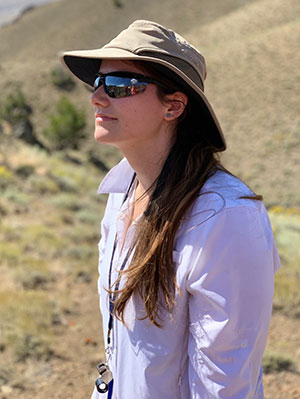
Contact Us
Institutional Communications
Bureau of Mines Building, Room 137
Laramie, WY 82071
Phone: (307) 766-2929
Email: cbaldwin@uwyo.edu

UWs Runyon Receives NSF Award to Study Critical Element Distribution in Central Wyoming
Published September 09, 2021

Simone Runyon
Simone Runyon, an assistant professor in the University of Wyoming’s Department of Geology and Geophysics, recently received a National Science Foundation (NSF) grant for research that investigates critical element distribution in the Rattlesnake Hills Alkaline Complex in central Wyoming.
The three-year, $274,610 grant, for a project titled “Processes Influencing Critical Element Enrichment in Alkaline Magmatic Systems,” began July 1 and continues through June 30, 2024. The project is jointly funded by UW’s Petrology, Geochemistry and Isotope Geology group and the Wyoming Established Program to Stimulate Competitive Research (EPSCoR).
“Understanding the controls on critical element distribution in these systems will better elucidate the evolution of shallowly emplaced, interpreted mantle-derived melts and the cycling of critical minerals in alkaline igneous complexes in the upper crust,” Runyon says. “Essentially, the more we understand how these elements behave in different geologic conditions, and what processes control their distribution, the better we might be able to explore for these resources in the future.”
The U.S. Geological Survey published a list of mineral commodities that are considered critical to the economic and national security of the United States. These critical mineral commodities include uranium, used mainly for nuclear fuel; platinum group metals, which are used for catalytic agents; and rare earth elements, which are used primarily for batteries and electronics.
The project at Rattlesnake Hills, located about 60 miles west of Casper, will investigate the igneous and hydrothermal processes that influence the distribution of platinum group elements (PGE) and rare earth elements in the magmatic complex that is 44 million to 48 million years old. The unique composition of the igneous rocks in the Rattlesnake Hills Alkaline Complex makes it an ideal place to investigate these processes.
Runyon says there have been “many great researchers” who have contributed to the understanding of the Rattlesnake Hills Alkaline Complex. This includes work by faculty from the UW Department of Geology and Geophysics, including Professors Carol Frost and James Myers, and their students; Wyoming State Geological Survey geologists; U.S. Geological Survey geologists; and graduate students from many different universities.
“Additionally, each company that has come into the area has contributed to our understanding of the geology,” Runyon says. “So, there are many contributors, more than there’s space to name here, who have helped establish the geologic foundation that we plan to build off of in our project.”
Runyon’s area of expertise is hydrothermal ore deposits, with a research portfolio that includes evaluation of element mobility in a variety of ore deposit types. Along with a team of graduate and undergraduate students, Runyon is investigating critical element enrichment and distribution in many deposits around Wyoming.
Additionally, Runyon’s research areas include investigating critical element enrichment and mobility in uranium roll-front deposits in Wyoming; alteration associated with PGE-enriched veins in the Medicine Bow Mountains; and deep forms of hydrothermal alteration in porphyry copper deposits in the American Southwest.
Contact Us
Institutional Communications
Bureau of Mines Building, Room 137
Laramie, WY 82071
Phone: (307) 766-2929
Email: cbaldwin@uwyo.edu

